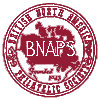Missing Colour on the 1983 32¢ Maple Leaf Definitive
Leopold Beaudet
(Posted on the Saskatoon Stamp Centre website in May 1998. Published in The Corgi Times, Vol. 6, No. 5, Mar.-Apr. 1998. A short version appeared in Linn’s Stamp News, 22 September 1997.)
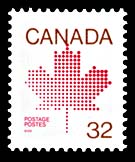
Almost 15 years after it was issued, a major error on the Canada 32¢ Maple Leaf definitive has come to light. In early August 1997, Ian Kimmerly, an Ottawa stamp dealer and auctioneer, was offered copies of the stamp with the beige background colour missing, thus leaving the background white — the “Winter Leaf” error. The tagging is also missing.
The finder reported that several panes of the 32¢ stamp had been bought from an Ottawa post office for a mailing. One pane had been split into several blocks and some stamps had been used before he noticed a discrepancy in the colour. An avid collector in his youth, he thought the stamps might be valuable so he gathered up what was left of the split pane as well as another half pane and other remnants with the beige colour missing. He also kept a pane that had the beige colour and looked normal. He put the stamps away and forgot about them. In August, his wife wanted to mail some letters, found the 32¢ stamps, and complained about needing two stamps to make up the 45c rate. Fortunately, her husband stopped her in time, and brought the stamps to Ian Kimmerly.
The finder sold Ian Kimmerly the following (the tagging is missing on all stamps):
- Seven blocks consisting of 54 stamps with the “Winter Leaf” error
- A block of 16 and a vertical strip of 4 from the top of a pane showing the beige gradually fading away
- A full pane with the normal beige colour, but with no tagging
The seven blocks and vertical strip of four are illustrated along with a normal stamp at the top right. Assuming that the blocks all came from the same pane, Ian Kimmerly reconstructed the pane as shown.
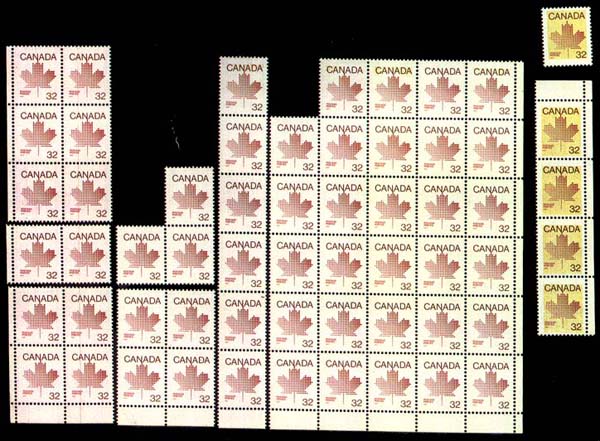
This reconstructed pane is a “transition” pane. The beige fades gradually in the top four rows. In the fifth row, stamps 5/1 and 5/2 are completely missing the beige, five stamps have a sliver of beige at the very top, and the remaining three are unaccounted for. The beige is completely missing on all the stamps in the bottom five rows.
How many copies of the “Winter Leaf” error were produced? How many exist? After the “transition” pane stamps, the finder sold Ian:
- A block of ten (two rows by five columns) with the left pane selvedge attached with the beige fading and tagging missing (probably the first five stamps from rows 3 and 4 of the transition pane)
- The bottom half of a second pane with beige and tagging completely missing
Now the story gets more complicated. Apparently the finder gave some of the errors to a friend. He sold the following:
- 5 copies to George S. Wegg Ltd. including an UL corner block of 4
- 17 copies to Sissons
- 13 copies to John Talman of Toronto
- 17 copies to Ian Kimmerly (of which one was thinned, one had paper sticking to it, and two were slightly creased)
Adding up all the missing (or almost missing in the case of the fifth row of the transition pane) beige errors, we have 54 copies from the transition pane plus 6 copies unaccounted for, a block of 50 from a second pane, and 52 additional copies, a few of which are damaged. If a few of the 52 additional copies are among the 6 unaccounted for from the transition pane, then the discovery consisted of just two panes; otherwise, it must have comprised most of the transition pane, a second pane, and part of a third.
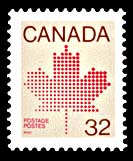
The 32¢ Maple Leaf definitive shows a stylized maple leaf printed in red on a beige background with the country and denomination printed in brown. British American Bank Note Co. (BABN) printed the stamp in panes of 100 (10 rows by 10 columns) on its Goebel rotary, web-fed press using two-colour photogravure (beige and brown) and one-colour intaglio (red).
The stamps are phosphor tagged with vertical bars along the left and right sides. The phosphor ink is also printed by photogravure.
Each colour was printed from a separate plate (or actually a cylinder since the design is impressed directly onto a cylinder, not a flat plate that is subsequently curved). The beige background was printed first and the red intaglio colour last. The brown lettering and tagging were printed between the beige and red, but the relative order is unknown.
The printing cylinders consisted of six panes, two along the axis of the cylinder by three around the circumference as shown in the illustration. The web is cut into individual panes (shown in dotted lines) by the slitters and guillotine. After they are cut, the “A” and “B” panes in the illustration are stacked in separate stacks at the end of the printing press. The gutter at the edges of the web and between the panes is discarded.
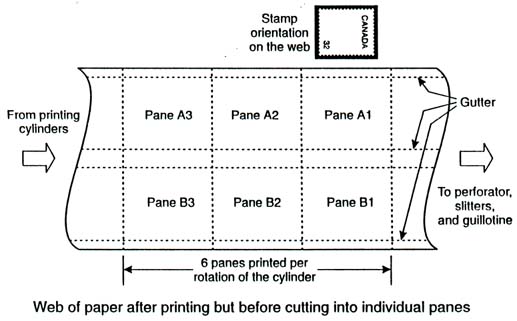
The transition pane and the second pane with the “Winter Leaf” error were likely printed consecutively. The same error would almost certainly have occurred on the tandem panes along the axis of the cylinder, but these have never been reported. A casual stamp user could easily miss the error because the design still looks “normal” with the beige missing, and the 32¢ coil and 50¢ booklet stamps have a white background. Perhaps there are copies lying around in kiloware somewhere.
How did the “Winter Leaf” error occur? Perhaps the printing press was slowing down or stopping at the point where the error occurred. When these panes were printed, perhaps the paper wasn’t being applied to the cylinders with enough pressure to pick up the ink, or the flow of ink was dropping off. On all the Winter Leaf errors, the red is shifted upwards such that it touches the “N” in “CANADA” (probably the basis of a good test for detecting fakes). If the printing press was slowing down, perhaps the brown and red cylinders were losing synchronization with each other. The red is NOT shifted on the pane with the normal beige colour but with the tagging missing. It must have been printed somewhat earlier in the press run.
When was the error produced? Canada Post issued the stamp on 10 February 1983 on Abitibi paper with white gum and plate 1 imprint. BABN reprinted the stamp on 31 August 1983 on Harrison paper with greenish gum and a plate 2 imprint. The difference in the gum is quite distinct. The gum on the “Winter Leaf” error is white, so the stamps were printed on Abitibi paper sometime between February and August 1983.
Has this type of error occurred before? What is it worth? Many Canadian stamps printed using a combination of lithography and intaglio are missing the intaglio colour. The printing method is prone to this type of error because separate sheet-fed presses are used to print the lithographic colours and the intaglio. The “Winter Leaf” is a far scarcer type of error because it was produced on a web-fed press, and not one but two photogravure inks are missing. In fact, such an error has occurred only once before on Canadian stamps, on the 14¢ Queen Elizabeth II definitive issued on 7 March 1978. The 14¢ stamp was also printed by BABN on its Goebel press. On this “White Queen” error, the red background colour and tagging are missing. Less than 300 copies are estimated to exist, and the error is valued at $2,000 Canadian in the 1998 Unitrade Specialized Catalogue of Canadian Stamps. A copy realised $950 (Canadian) + 10% buyer’s fee in a recent Ian Kimmerly auction (auction #91, 27 August 1997, lot 283).
K. Bileski wrote an excellent article about the discovery of the “White Queen” in a booklet he published in 1982, Some Canadian Stamp Errors... In it, he illustrates parts of the four panes found with the error. The post office clerk numbered the panes in the top left corner. Stamp 1/1 on both pane 1 and pane 4 has the “creased forehead” constant cylinder flaw. The frequency of this flaw indicates that the 14¢ QE II definitive was printed, guillotined, and stacked the same way as the 32¢ Maple Leaf.
Gary J. Lyon bought all but ten copies of the “Winter Leaf” error. He also bought the blocks with fading beige and the untagged but otherwise normal pane of 100. Of the ten copies he didn’t buy, the original finder kept a LL corner block, Ian Kimmerly sold a single to a collector, and Saskatoon Stamp Centre acquired the other five copies. Gary Lyon advertised the errors in the 14 October 1997 issue of Canadian Stamp News (CA$1,295 for a single and $4,995 for a block of four) and the 13 October 1997 issue of Linn’s Stamp News.
Copyright © 1998 Leopold Beaudet
Web design copyright © 2013-2025 The British North America Philatelic Society.
The documents on this website are for informational and non-commercial or personal use only.
Documents on this website shall not be used on other websites or for commercial purposes without permission.
This page was last modified on 2022-01-20
